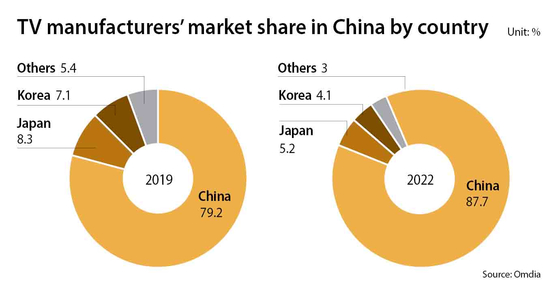[NEWS ANALYSIS] Korean home appliance firms struggle for foothold in China
![A visitor looks at Samsung Electronics' 89-inch Micro LED TV exhibited at a mall in Shanghai, China, in May. [YONHAP]](https://koreajoongangdaily.joins.com/data/photo/2023/07/02/569e962f-2c59-45af-91bc-66babffa195d.jpg)
A visitor looks at Samsung Electronics' 89-inch Micro LED TV exhibited at a mall in Shanghai, China, in May. [YONHAP]
Korean TVs from Samsung Electronics and LG Electronics accounted for a mere 4.1 percent of China’s TV market in 2022, according to market tracker Omdia.
That represents 3 percentage points drop from 2019.
Market share of Chinese TVs, which include a vast range of brands including Huawei, Hisense and TCL, expanded to 87.7 percent in 2022, compared to 79.2 percent in 2019.
In terms of refrigerators, the number of Korean refrigerators imported to China shrunk by 21.8 percent in 2022 year-on-year.
Neither Samsung nor LG were included in the top 10 refrigerator brands sold in the country last year, according to global market tracker AVC.
“In the past, Samsung and LG together accounted for two to three percent [of the Chinese market] and were listed in the top 10 [refrigerator brands sold in China],” said Ko Sung-ho, a deputy director at Korea Trade-Investment Promotion Agency.
Haier, a value-for-money Chinese consumer electronics brand, accounted for 32.7 percent of the market taking the lead. Germany's Siemens was the only foreign brand included in the list.
"Korean brands are stuck in the middle where price-sensitive consumers opt for Chinese brands with cheap price tags and also good quality, while those who want premium opt for 'ultra-premium' and go for Western brands," said Ko.
"Due to the latest geopolitical issue between Korea and China on top of the Thaad situation in which the consequences are still lingering, the Chinese don't tend to prefer Korean products if they don’t offer something extra top-notch."
Korean products were largely neglected in China back in 2015 when the two countries' opinions differed over the deployment of the Terminal High Altitude Area Defense system, also known as the Thaad. The conflict led multiple Korean retailers to scrap their Chinese business at the time.
The vacancy of Korean products during the period was quickly filled with fast-evolving local brands which offer up-to-standard quality at a much cheaper price.
Korean TV brands have always targeted the premium TV market in China, but their aim has moved up a notch recently to hold a competitive edge over Chinese rivals as their technology development picked up speed.
Chinese brands, which used to focus on cheaper LCD TVs, have been launching OLED TVs in recent years.
Huawei and Xiaomi, for example, which used to concentrate on LCD TVs, rolled out their first OLED TV in China in 2020.
OLED, short for Organic Light Emitting Diode, provides a richer color range than LCD and is considered more high-tech and premium.
"Competing in the LCD TV [space] is meaningless because their price is unbeatably backed by government incentives and integrated supply chain as they are sourced by LCD panel from either China or Taiwan," said an industry source.
"The situation is not that good for premium as well because now local brands offer products in the premium lineup too.”

Samsung Electronics revealed the latest 89-inch Micro LED TV at the Appliance & Electronics World Expo held in China early this year. It costs 118 million won per unit. Samsung had previously launched the 110-inch Micro LED TV that costs 170 million won in China too.
"The Micro LED TV stands at the pinnacle of Samsung’s TV technology and targets the smallest niche market," said a Samsung Electronics spokesman. “Samsung is targeting the premium market.”
LG Electronics also aims high in China as it recently launched the rollable OLED TV with a price tag of more than 100 million won.
BY JIN EUN-SOO [jin.eunsoo@joongang.co.kr]










with the Korea JoongAng Daily
To write comments, please log in to one of the accounts.
Standards Board Policy (0/250자)